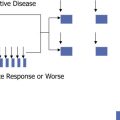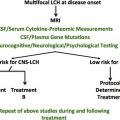Hemophagocytic lymphohistiocytosis (HLH) is a rare but potentially fatal syndrome of pathologic immune dysregulation characterized by clinical signs and symptoms of extreme inflammation. HLH can occur as a genetic or sporadic disorder and, though seen as an inherited condition affecting primarily a pediatric population, can occur at any age and can be encountered in association with a variety of underlying diseases. Clinically the syndrome, whether genetic or acquired, is characterized by fever, hepatosplenomegaly, cytopenias, and activated macrophages in hematopoietic organs. Therapy centers on suppression of this hyperinflammatory state with cytotoxic, immunosuppressive therapy and treatment of any existing HLH triggers.
Key points
- •
Acquired hemophagocytic lymphohistiocytosis (HLH), though seen in the pediatric population, is the more common form of HLH in adults, often triggered by an underlying infection, malignancy, or rheumatologic condition.
- •
Acquired HLH is a highly morbid condition; if left untreated, patients survive for only a few months because of progressive multisystem organ failure.
- •
The treatment paradigm of adult HLH is largely based on the pediatric, HLH-1994 protocol. Further work is needed to refine the diagnostic criteria and treatment algorithm for the adult population.
Introduction
Hemophagocytic lymphohistiocytosis (HLH) is a rare but potentially fatal syndrome of pathologic immune dysregulation characterized by clinical signs and symptoms of extreme inflammation. The pathology of the condition centers on the activation and proliferation of uncontrolled macrophages and lymphocytes, culminating in an unrelenting cytokine storm and subsequent tissue infiltration and multiorgan system failure.
HLH can occur as a genetic or sporadic disorder and, though seen as an inherited condition affecting primarily a pediatric population, can occur at any age and be encountered in association with a variety of underlying diseases. Genetic HLH occurs in familial forms (fHLH), in which HLH is the primary and only manifestation, and in association with immune deficiencies such as Chédiak-Higashi syndrome, Griscelli syndrome, and X-linked lymphoproliferative syndrome, whereby secondary HLH occurs sporadically and is often a terminal phase of the disease. Acquired HLH, though seen in the pediatric population, is the more common form of HLH in adults and is often triggered by an underlying infection, malignancy, or rheumatologic condition ( Box 1 ). Clinically the syndrome, whether genetic or acquired, is characterized by fever, hepatosplenomegaly, cytopenias, and the finding of activated macrophages in hematopoietic organs, often resulting in multiorgan system failure and death. Therapy centers on the suppression of this hyperinflammatory state, focusing on the destruction of cytotoxic T lymphocytes and macrophages with cytotoxic, immunosuppressive therapy and treatment of any existing HLH triggers.
Genetic
- 1.
Familial
- •
Known genetic defects: PRF1 , MUNC13-4 , STX1 , STXBP2
- •
Unknown genetic defects
- •
- 2.
Immune deficiency syndromes
- •
Chédiak-Higashi syndrome, Griscelli syndrome, X-linked lymphoproliferative syndrome: LYST , RAB27α
- •
Acquired
- 1.
Infections
- •
Viral, bacterial, fungal
- •
- 2.
Malignancy
- 3.
Autoimmune conditions
- 4.
Others: posttransplantation, pregnancy, drug-induced
Introduction
Hemophagocytic lymphohistiocytosis (HLH) is a rare but potentially fatal syndrome of pathologic immune dysregulation characterized by clinical signs and symptoms of extreme inflammation. The pathology of the condition centers on the activation and proliferation of uncontrolled macrophages and lymphocytes, culminating in an unrelenting cytokine storm and subsequent tissue infiltration and multiorgan system failure.
HLH can occur as a genetic or sporadic disorder and, though seen as an inherited condition affecting primarily a pediatric population, can occur at any age and be encountered in association with a variety of underlying diseases. Genetic HLH occurs in familial forms (fHLH), in which HLH is the primary and only manifestation, and in association with immune deficiencies such as Chédiak-Higashi syndrome, Griscelli syndrome, and X-linked lymphoproliferative syndrome, whereby secondary HLH occurs sporadically and is often a terminal phase of the disease. Acquired HLH, though seen in the pediatric population, is the more common form of HLH in adults and is often triggered by an underlying infection, malignancy, or rheumatologic condition ( Box 1 ). Clinically the syndrome, whether genetic or acquired, is characterized by fever, hepatosplenomegaly, cytopenias, and the finding of activated macrophages in hematopoietic organs, often resulting in multiorgan system failure and death. Therapy centers on the suppression of this hyperinflammatory state, focusing on the destruction of cytotoxic T lymphocytes and macrophages with cytotoxic, immunosuppressive therapy and treatment of any existing HLH triggers.
Genetic
- 1.
Familial
- •
Known genetic defects: PRF1 , MUNC13-4 , STX1 , STXBP2
- •
Unknown genetic defects
- •
- 2.
Immune deficiency syndromes
- •
Chédiak-Higashi syndrome, Griscelli syndrome, X-linked lymphoproliferative syndrome: LYST , RAB27α
- •
Acquired
- 1.
Infections
- •
Viral, bacterial, fungal
- •
- 2.
Malignancy
- 3.
Autoimmune conditions
- 4.
Others: posttransplantation, pregnancy, drug-induced
Acquired hemophagocytic lymphohistiocytosis
Acquired HLH can present at any age, although it is more typically encountered in the adult population with a mean age at diagnosis of 48 to 50 years old. It is associated with a wide variety of conditions including infection, malignancy, autoimmune disorders, and immunosuppression. These entities have been linked to the development of HLH in the literature; however, there are also case reports of lesser described triggers including medications, pregnancy, and post-hematologic and solid organ transplantation.
The clinical presentation of acquired HLH is similar to the familial form, and the diagnostic criteria remain the same. However, as the criteria for diagnosis were developed in the context of pediatric patients, there is considerable interest in adapting the diagnostic criteria to improve the diagnosis of HLH in adults. Genetic testing in these patients reveals a subset that displays heterozygous mutations and polymorphisms in the known fHLH genes ( Table 1 ). In one study of adult patients who met the criteria for HLH, missense and splice-site sequence variants in PRF1 , MUNC13-4 , and STXBP2 were present in 14% of patients, and the A91V-PRF1 genotype was found in 4.8%. Hypomorphic alleles for fHLH genes are implicated in approximately 15% of acquired HLH. However, to date there are no data to indicate whether the prognosis of patients who possess these defects differs from those in whom such polymorphisms are not identified.
| HLH Subtype | Genetic Defect | Resulting Defect |
|---|---|---|
| FHL1 | 9q21.3-locus 6 | Unknown |
| FHL2 | PRF1 | Vesicle content |
| FHL3 | UNC13D | Defective cytolytic granule exocytosis |
| FHL4 | STX18B | Defective intracellular transport |
| FHL5 | UNC18B | Defective membrane fusion |
Infection
Viral infection, either as a primary infection or reactivation in an immunosuppressed host, is a frequent trigger of acquired HLH. In a large study of 96 adult patients from Taiwan with HLH, 30 were associated with infection. The most common types of infection were viral (41%), mycobacterial (23%), bacterial (23%), and fungal (13%). The Epstein-Barr virus (EBV) is the most common viral pathogen linked to the development of HLH. EBV is postulated to cause a clonal proliferation and hyperactivation of EBV-infected T cells in patients with EBV-associated HLH. Other viral pathogens linked to the disorder include cytomegalovirus, parvovirus, herpes simplex virus, norovirus, varicella zoster virus, measles virus, human herpes virus 8, H1N1 influenza virus, and human immunodeficiency virus (HIV). In one retrospective analysis of 162 patients with HLH, approximately 25% were found to have an infectious trigger, with approximately half of these cases thought to be secondary to HIV. Although less commonly reported, HLH may also occur in the setting of infections caused by bacteria ( Mycobacterium tuberculosis , Ricksettsia , Escherichia coli ), parasites ( Leishmania ), and fungi ( Histoplasma ).
Malignancy
The development of HLH in individuals with an underlying malignancy has been clearly described. The hematologic malignancies, specifically lymphoma, are the most common cause of malignancy-associated HLH. Among lymphomas, T-cell lymphoproliferative disorders, such as anaplastic large cell lymphoma and natural killer (NK) cell lymphoma, are the most frequently linked to HLH. A recent survey of adult patients with HLH reported that more than half (52%) were associated with malignancies. Of these cases, approximately 59% were associated with T-cell lymphoma and 19% were linked to diffuse large B-cell lymphoma. Data are limited as to whether the malignancy itself is causative of HLH or whether the malignancy places the patient at increased risk of infection that ultimately triggers the syndrome.
Autoimmune Conditions, Macrophage Activation Syndrome
Several autoimmune conditions are known precipitants of HLH including systemic lupus erythematosus (SLE), mixed connective tissue disorder, dermatomyositis, systemic sclerosis, and Kikuchi disease. HLH may develop at any time during the course of a rheumatologic disorder, on presentation, during therapy, or at time of flare. The specific term macrophage activation syndrome (MAS) is typically used when a hemophagocytic syndrome develops in children with juvenile idiopathic arthritis and other rheumatologic conditions, but it has also been documented as a syndrome in adults, the limited data for which suggest that it is seen most frequently in association with adult-onset Still disease, SLE, and various vasculitic syndromes. The primary clinical manifestations of adult-onset MAS are identical to those in pediatric patients and include fever, lymphadenopathy, hepatosplenomegaly, and liver function test (LFT) derangements. In addition to similar clinical manifestations, MAS and HLH also share genetic similarities. Polymorphisms and heterozygous mutations in PRF1 and UNC13D have been identified in MAS patients, most of whom also have decreased NK function, elevated soluble CD25 (sCD25), and elevated soluble CD163 (sCD163).
Diagnosis
The diagnosis of acquired HLH, especially in adults, is often difficult, and may frequently not be considered or confirmed before a patient’s death. The primary problem is the lack of a specific disease marker, as the clinical picture is often nonspecific and mimics alternative infectious or malignant conditions. Many of the initial, nonspecific tests that are helpful in evaluating HLH (complete blood count, coagulation studies, and LFTs) are completed in the evaluation of an unexplained febrile illness. Additional markers, including serum ferritin, triglycerides, and screening immunologic studies, are ordered when suspicion for HLH mounts.
Although the significance of the results remains to be determined, the author recommends that mutation analysis be requested for all adult cases of confirmed or suspected HLH at some time during their course, with analysis of the known fHLH mutations ( PRF1 , UNC13D , STX11 , and UNC18B ), as a subset will possess heterozygous mutations and polymorphisms in the known fHLH genes. That said, negative results will be found in most of the adult population. As the presence or absence of a mutation does not alter treatment, appropriate therapy should not be delayed while awaiting results, and in fact testing need not be done at the time of initial evaluation. However, the presence of an fHLH mutation may provide guidance in decisions regarding ongoing therapy or transplantation for patients who achieve remission with initial HLH therapy. It must be stressed that the clinical importance of finding hypomorphic fHLH alleles remains to be established in the adult population, but whether such mutations predict a course that is different from that in patients without mutations should become clearer as the disease becomes better recognized and testing becomes more universal. The Histiocyte Society developed a set of diagnostic criteria in 1994 to help clinicians identify pediatric patients with both familial and acquired HLH on clinical and laboratory grounds. These criteria were later refined in 2004 ( Box 2 ) to include decreased NK-cell function and elevated sCD25 or serum-soluble interleukin-2 receptor (sIL-2R) levels. It should be noted that although these recently added markers (NK function, sIL-2R) are helpful in establishing a diagnosis, testing often requires sending samples to specialized laboratories, and these results are not always available to help with a timely diagnosis. It should also be recognized that these criteria were developed for the diagnosis of pediatric patients and may not be best suited to making the diagnosis of HLH in adults.







